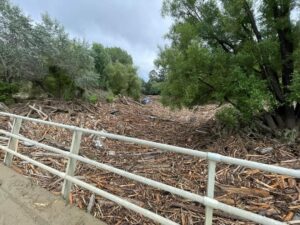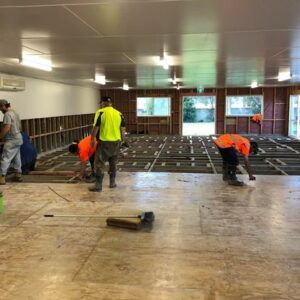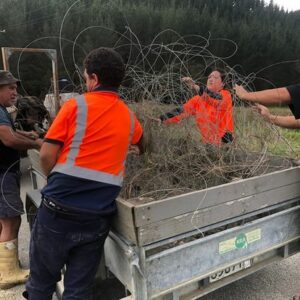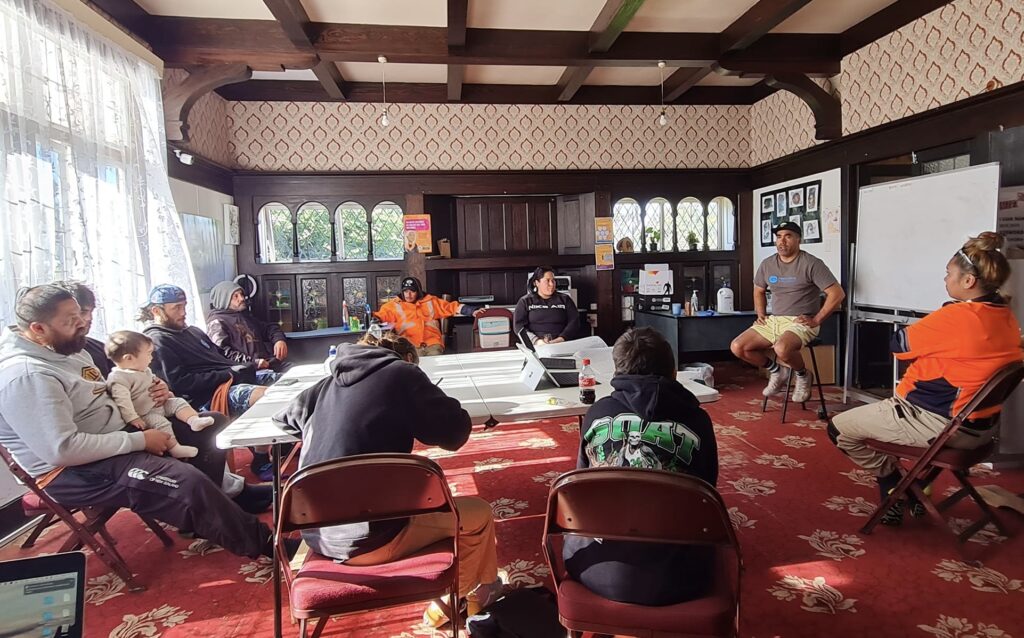Since 2018 Te Tairāwhiti has experienced a number of unprecedented weather events. Most recently in 2023 back-to-back cyclones Hale and then Gabrielle. Leaving in their wake, devastating ecological and biological disasters. Rawinia Kingi, one of our Poutautoko in Tairāwhiti, shares her story of the road to recovery through Huiterangiora Kaitiaki, which Te Aho Tū Roa partnered to support the needs of this growing kaupapa.

Slash fills the rivers after the cylcone.
My desire to help whānau that were affected by the cyclones came into fruition through a kaupapa that was being led out by Huiterangiora Foundation. Supported by MSD and their Flexiwage project, Huiterangiora Foundation employed 14 locals from Uawa, mostly MSD clients, to undertake the mammoth task of cyclone recovery. The kaupapa was to be known as Huiterangiora Kaitiaki.
It soon became evident that the cyclone recovery efforts were not just about the physical recovery of properties, it was very much about the recovery of people’s hearts, spirits and minds. We also knew that we had to switch from recovery in the present to thinking inter-generationally about preventions and safeguarding taiao for future generations.

eDNA on Uawa rivers with Mere Tamanui
TAIAO RECOVERY
We had a shared understanding that engaging, connecting and considering taiao practices are important to both TATR and HTRO kaupapa. The recovery work was not just about the immediate work that needed to be done around properties but thinking intergenerationally about how we can future proof kāinga by working alongside taiao.

Kaitiaki mahi māra hei whāngai i te iwi
The kaitiaki were regulars at local taiao meetings and gatherings such as Raukūmara Pae maunga hui, Kaitawa Estuary & catchment planning hui. They also participated in Slash for Cash training and Myrtle Rust workshops. Under the guidance of Mere Tamanui they engaged in water monitoring, EDnA testing, pest trapping exercises and nursery work. They learnt how to eco-source, process, sow and grow natives from seed, also a part of releasing established riparian plants in Anaura Bay.
Over 3000 Native Tree plantings were put in to the ground along the riparian strip of Pātiki River at Tokomaru and a Tauwhareparae property that borders the Mangaheia River. They also supported a further 3,000 plants propagation this planting season.
Supporting our native tree efforts was incorporating the growing and distribution of kai māra into the Kaitiaki weekly workplans, providing all-year round access to kai, a direct response to being cut off from food supplies during the cyclones.
We understand that oranga tangata is directly connected to oranga taiao. Ki te hāhā te whenua, ka hāhā te tangata. We are a part of, not separate to our taiao, tiakina!
KAINGA RECOVERY
The cyclone clean-up provided a lot of mental and spiritual support for the families that were affected directly by the cyclone. A key part of what was provided for whānau was cyclone recovery clean-up which included planning, connecting and working with the families and providing the manpower to do the mahi.
The skills learnt were removal and repurposing of silt from homes and properties. Clearing of properties, marae and urupā and repairing damage to assist in the regeneration of the land and community. The kaitiaki (kaimahi) learnt skills on the job such as fencing, chainsaw use and maintenance, landscaping, weed eating/ scrub cutting and the underrated shovel work.
Kaitiaki said the most rewarding part about their mahi, was being able to help our whānau, seeing the appreciation on whānau faces when whānau would see them pull up the driveway and at work.
I went out home this arvo and was blown away. My sheds look beautiful, better than before the cyclone happened. Im so thankful and I appreciate the awesome mahi. It brought a tear to my eyes. Ngā mihi nui.

Kaitiaki helping at Mangatuna Marae with lifting of the silt affected floors

Kaitiaki helping whānau with breaking down and tidying up silt effected fences.
TANGATA RECOVERY
It is important to both kaupapa that we strengthen the wellbeing of our people and foster healthy relationships. We know that connection to culture and identity does this and they were provided with opportunities for their kete to be filled, which came with life changing experiences.
HTRO achieved, created and established an ongoing relationship with Tairāwhiti Waka for the community that’s involved with Huiterangiora. We engaged the services of Maahanga Aio Ltd to deliver 3 x1 day wānanga, a young couple starting out, whom have captained and navigated the many oceans of the Pacific.
The Kaitiaki attended weekly Te Reo Māori sessions and were available to support at the marae when required. The growth and confidence in our whānau was exponential from feeling uncomfortable with speaking or being in Māori environments to embracing these.
Upskilling was also a key component of the kaupapa. Our Kaitiaki received ID followed by driving licences and some their Wheels, Tracks and Rollers tickets. Through EIT they achieved First Aid, Chainsaws, Fencing, Safe work practices and Quad certificates.
We know that connecting our whānau to their culture has created a stronger sense of identity and providing learning opportunities has opened more doors to the world.
“This kaupapa has helped change the course of my life. I have more confidence in myself and what I can offer.”

Katiaki wananga with Regan Pahewa around catchments. How they work & what we can be doing to support them
Ngauru and Uncle Te Miroa onboard Tairawhiti Waka Hourua
Kaitiaki receving their drivers licences through REAP Tairawhiti





